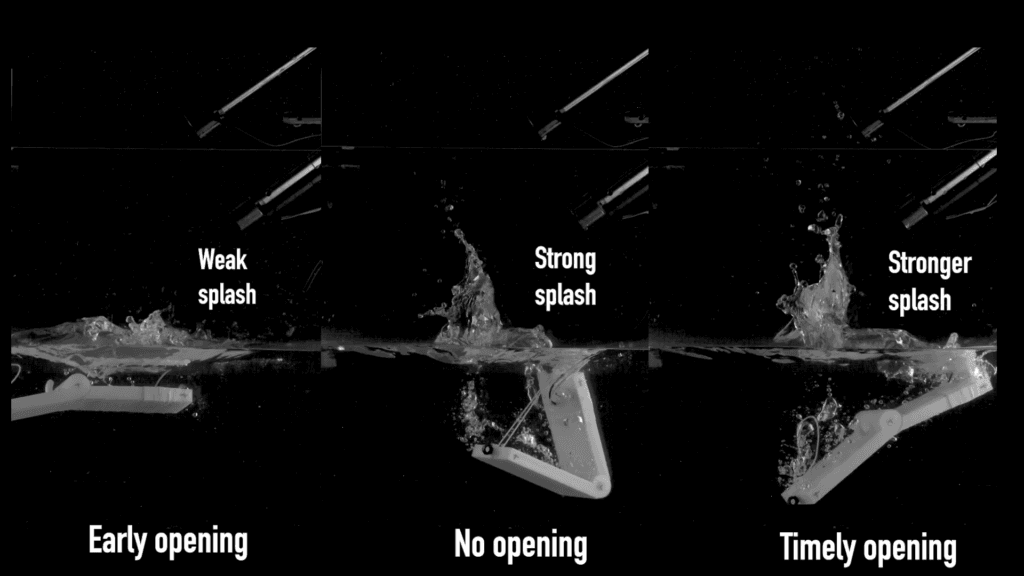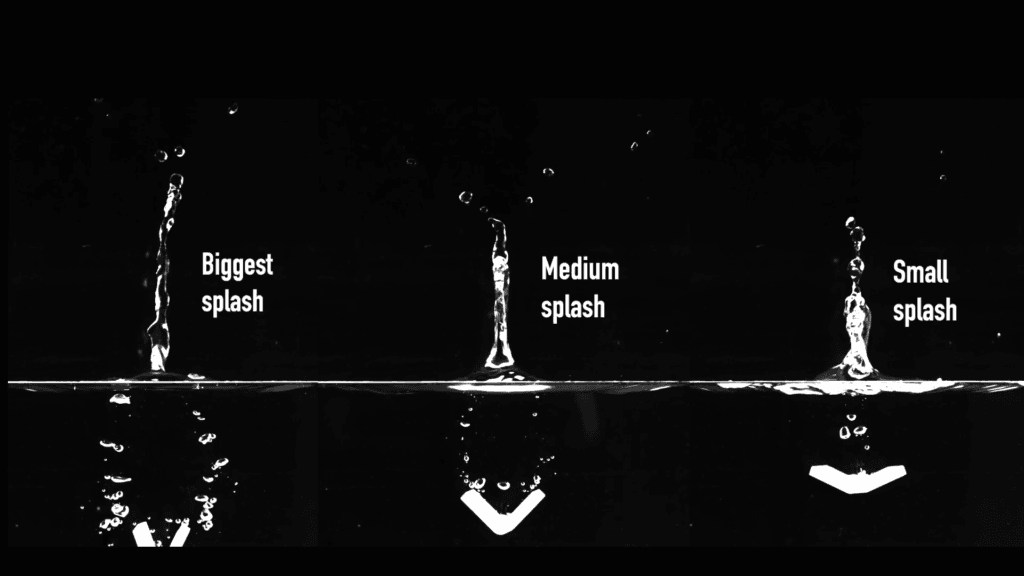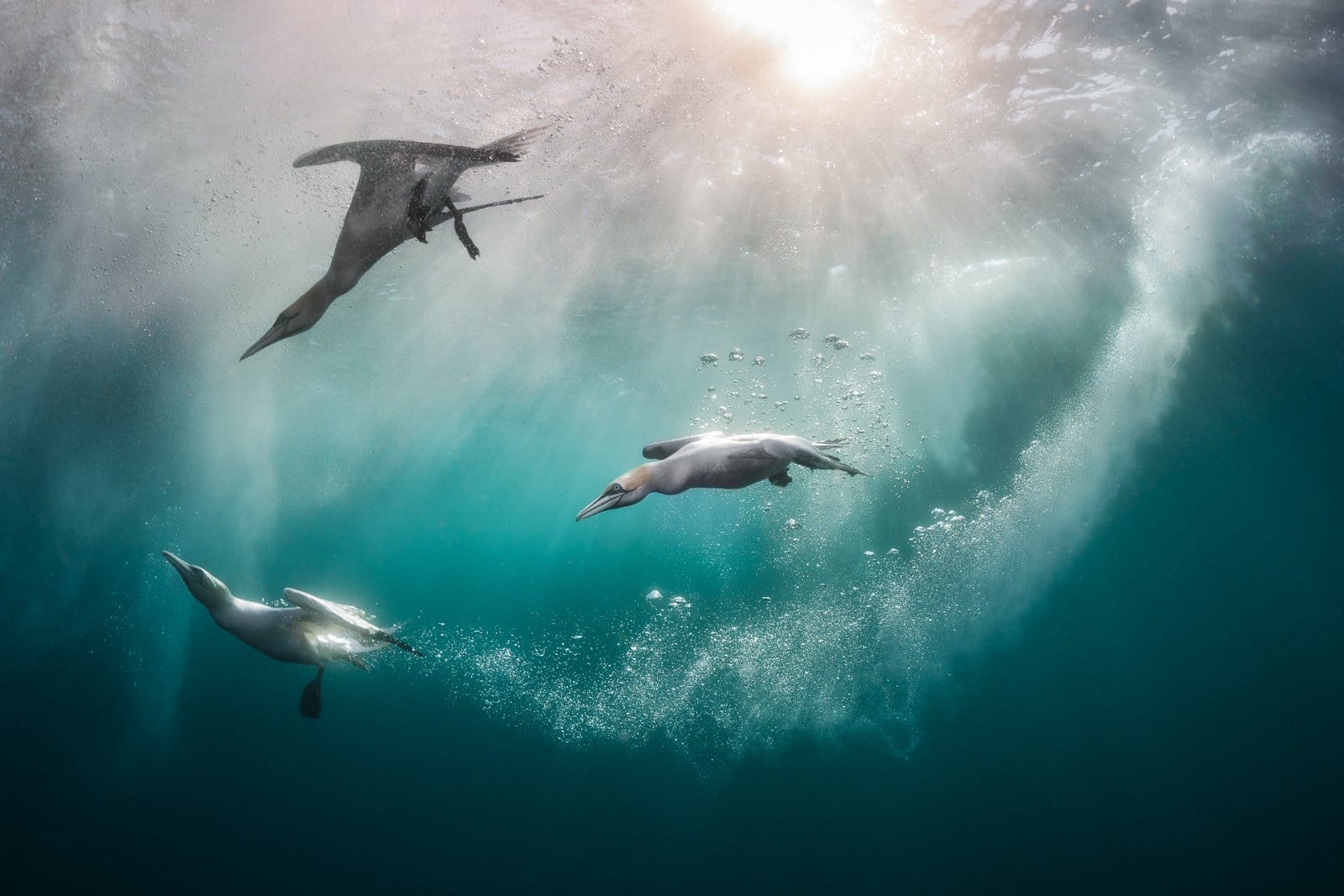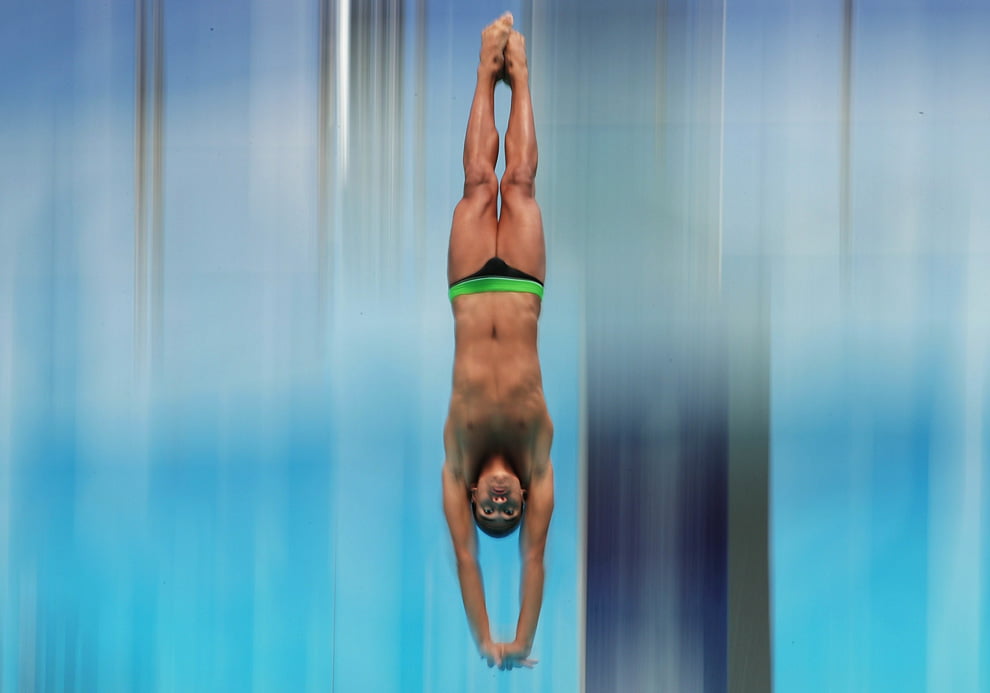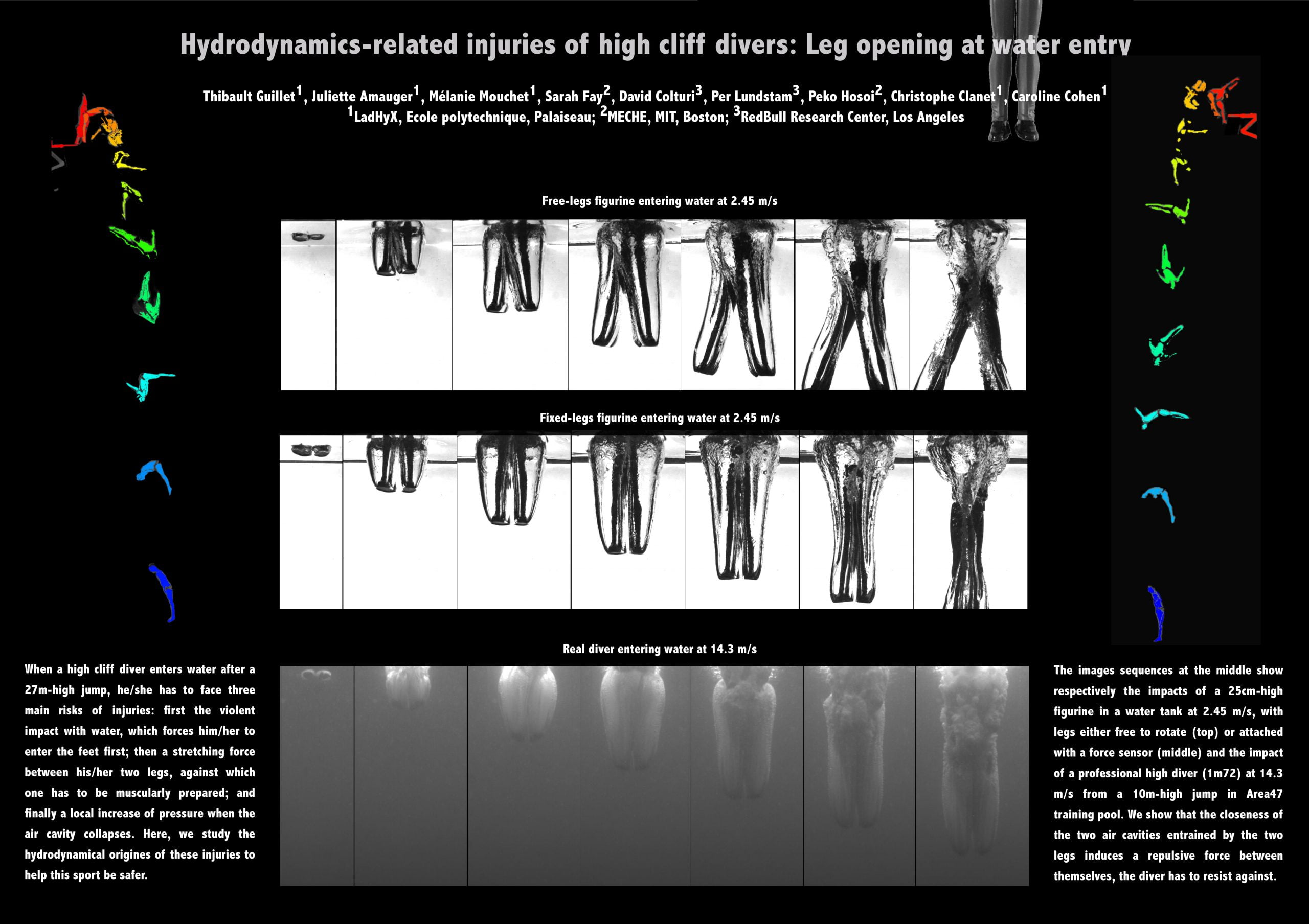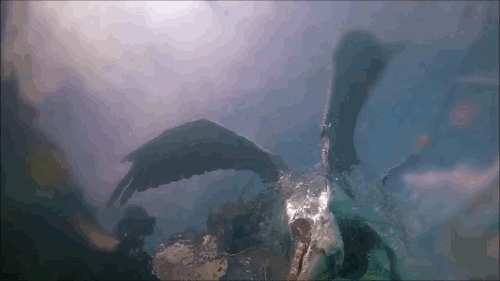The Māori people of Aotearoa New Zealand compete in manu jumping to create the biggest splash. Here’s a fun example. In this video, researchers break down the physics of the move and how it creates an enormous splash. There are two main components — the V-shaped tuck and the underwater motion. At impact, jumpers use a relatively tight V-shape; the researchers found that a 45-degree angle works well at high impact speeds. This initiates the jumper’s cavity. Then, as they descend, the jumper unfolds, using their upper body to tear open a larger underwater cavity, which increases the size of the rebounding jet that forms the splash. To really maximize the splash, jumpers can aim to have their cavity pinch-off (or close) as deep underwater as possible. (Video and image credit: P. Rohilla et al.)
Tag: diving

“Immersion”
Some seabirds, including gannets and boobies, feed by plunge diving. From high in the air, they fold their wings and dive like darts into the water, impacting at speeds around 24 m/s to help them reach the depths where their prey swim. With their narrow beaks and necks, the critical moments in this feat come when the bird’s head is submerged but its body remains out of the water. At this point, the bird’s head is decelerating quickly and its body is still moving at full speed; if the neck cannot withstand this combination of forces, it will buckle.
But plunge divers, it turns out, have a secret weapon that helps them handle impact: their head shape. A study of water entry dynamics using 3D-printed models of birds’ heads found that plunge divers have a shape that increases the amount of time it takes to enter the water. The impact forces stretch out over that longer period of contact, which also stretches out the time it takes for the bird to reach its maximum deceleration. The end result? That extended contact time protects birds from unsafe levels of deceleration, just like a crumple-zone in a crashing car keeps its occupants from experiencing the worst decelerations. (Image credit: K. Zhou/BPOTY; research credit: S. Sharker et al.; via Colossal)

Paris 2024: Diving
In competition diving, athletes chase a rip entry, the nearly splash-less dive that sounds like paper tearing. Part of a successful rip dive comes in the impact, where divers try to open a small air cavity with their hands that their entire body then enters. But the other key component happens below the surface, where divers bend at the hips once underwater. This maneuver enlarges the air cavity underwater and disrupts the formation of a jet that would typically shoot back upwards. Done properly, the result is an entry with little to no splash at the surface and a panel full of pleased judges. (Image credits: top – A. Pretty/Getty Images, other – E. Gregorio; research credit: E. Gregorio et al.; via Science News; submitted by Kam-Yung Soh)

Sequence of images showing a synthetic diver bending underwater to disrupt splash formation. Related topics: Rip entry physics, how pelicans dive safely, and how boobies plunge dive
This post marks the end of our Olympic coverage for this year’s Games, but if you missed any previous entries, you can find them all here.

“Divebomb”
Seabirds like gannets and boobies are engineered for diving. They fly to a certain altitude, locate fish underwater, and then fold themselves into a streamlined projectile. With this, they plunge into the water at high-speed, positioned to protect themselves from the forces of impact. Under the water, they dart among their prey, hunting with singular purpose. Photographer Kat Zhou’s “Divebomb” captures the underwater side of this behavior, while showing off the energetic bubbles (and bubble rings!) created by the birds. (Image credit: K. Zhou; via UPY 2024 and Colossal)

Tokyo 2020: High-Dive Physics
In Olympic high-diving, athletes leap from a maximum of 10 meters above the water. Although the force of their water impact is substantial, it’s small enough that they can enter the water head first. For cliff divers — who may jump from 27 meters! — the impact force is too great to risk a head-first entry, so they enter the water feet first. But this does not eliminate their risk of injury.
As the diver’s body enters the water, each leg creates its own cavity, and the proximity of the two cavities generates a repulsive force. If the diver isn’t prepared to resist that force, it will force their legs apart, potentially injuring them. (Image and research credit: T. Guillet et al.)

Reducing the Force of Water Entry
As anyone who’s jumped off the high board can tell you, hitting the water involves a lot of force. That’s because any solid object entering the water has to accelerate water out of its way. This is why gannets and other diving birds streamline themselves before entering the water. But even for non-streamlined objects, like a sphere, there are ways to reduce the force of impact.
This video explores three such techniques, all of which involve disturbing the water before the sphere enters. In the first, the sphere is dropped inside a jet of fluid. Since the jet is already forcing water down and aside when the sphere enters, the acceleration provided by the sphere is less and so is the force it experiences.
The second and third techniques both rely on dropping a solid object ahead of the one we care about. In the second case, a smaller sphere breaks the surface ahead of the larger one, allowing the big sphere to hit a cavity rather than an undisturbed surface. Like with the jet, the first sphere’s entry has already accelerated fluid downward, so there’s less mass that the bigger sphere has to accelerate, thereby reducing its impact force.
In the third case, the first sphere is dropped well ahead of the second, creating an upward-moving Worthington jet that the second sphere hits. In this case, there’s water moving upward into the sphere, so how could this possibly reduce the force of entry? The key here is that the water of the jet wets the sphere before it enters the pool. Notice how very little air accompanies the second sphere compared to the first one. That’s because the second sphere is already wet. It’s also been slowed down by the jet so that it enters the water at a lower speed, all of which adds up to a lower force of entry. (Image and research credit: N. Speirs et al.)


Pelican Diving
Pelicans, like many sea birds, are aerial divers. They spot their prey from high above, bank, and dive into the water to catch the fish. Although they hit the water at high speeds, pelican diving techniques differ somewhat from plunge divers like gannets or boobies. Pelicans are only aiming for a shallow dive, so they have features – like their expandable neck pouch – that help them decelerate quickly instead of taking a full-body plunge. The goal is to increase drag after the head enters, slowing everything down. That can add more stress to the bird’s neck – the rest of the body is still moving quickly even after the head begins to slow. To counter this compression, the birds must have strong neck muscles to stabilize their spines during the impact process. (Video and image credit: Deep Look)


Rio 2016: Diving
Diving is a popular event for spectators, but it can also be rather confusing. We know that divers are rewarded for minimizing their splash, but what exactly does that mean and how do they do it?
The ideal water entry, called a rip entry by divers, requires a diver to hit the water in a vertical orientation with their arms braced and palms held flat over their head. Striking the water tears open a cavity for the athlete’s body to enter. To minimize splash, the diver wants to fall into this expanding cavity without striking the sides, which would throw up an additional splash. This is the reason for vertical entry. Hand position is also important. If the athlete were to point their fingers, they would create a narrower cavity and larger splash.
After the athlete enters the water, the cavity closes off under the surface and the water rebounds in a splashy Worthington jet. For the speed and size of human divers, this later splash is essentially unavoidable. What the commentators don’t really tell you, though, is that diving judges are only supposed to judge a diver’s entry up to the point that their feet go under the surface. They’re instructed to ignore everything that happens underwater and after entry. So that big rebound splash we all see isn’t meant to count! (Image credits: A. Pretty/GettyImages; kaorigoto, source)
Previously: Minimizing splash by being hydrophilic; the physics of skipping rocks and avoiding splashback at the urinal
Join us throughout the Rio Olympics for more fluid dynamics in sports. If you love FYFD, please help support the site!

London 2012: Diving Physics
Divers twist and spin gracefully in the air, but the highest marks come when they enter the water with little to no splash. This rip entry–named after paper-ripping sound characteristic of such a dive–is possible thanks to fluid dynamics. Any time a solid object enters a still liquid, it tears a cavity into the liquid. The smaller this cavity is, the less the liquid will rebound and splash when the cavity gets refilled. In diving, achieving a small splash requires a couple items. First, the diver will grab his hands over his head to form a flat surface. This will create the initial small cavity through which his body follows. When entering, the diver will keep his body straight and rigid, with arms pressed against his head; this adds stability to keep the diver from letting the force of striking the water at 35 mph affect his body’s form and create splash. Finally, the perfect dive enters vertical to the water surface. This ensures that all of the diver’s body finds its way into that cavity created by the hands without striking any undisturbed water. Once under the water, divers often extend their arms to generate enough drag to slow down quickly. All in all, the rip entry minimizes the cavity size and thus the splash, adding a great exclamation point to a beautiful dive. (Photo credits: Associated Press, Adam Pretty/Getty Images, Nigel Wade, Jed Jacobsohn)
FYFD is celebrating the Olympics by featuring the fluid dynamics of sport. Check out our previous posts on how the Olympic torch works, what makes a pool fast, the aerodynamics of archery, the science of badminton, and how cyclists “get aero”.


